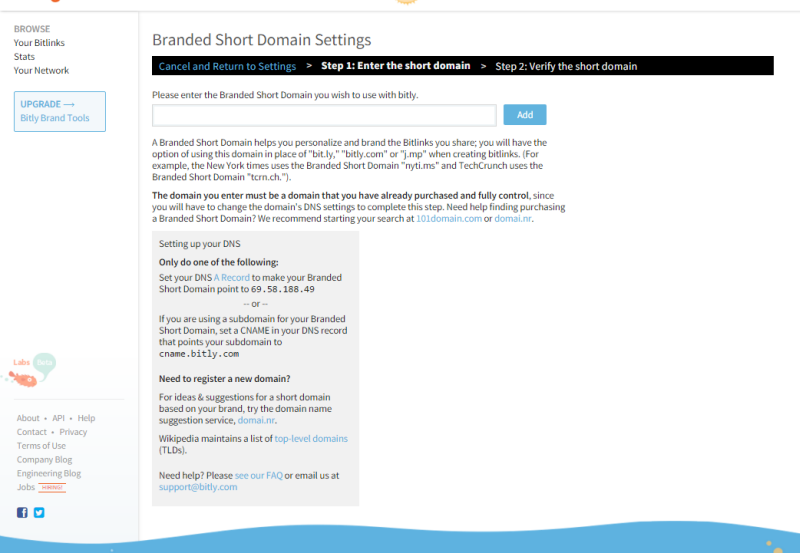In an article on how to track campaigns in Google Analytics, I explained how to tag urls to your site to track promotional and marketing efforts. As this generates a long url, the recommendation is to shorten them before use. An additional way to brand your site as well as separate tracking data is to use a custom or branded url to use in your promotions.
Branded Short Domains for Your Business
What is a branded short domain, also known as a custom vanity link? It is an extremely abbreviated url that can represent your company. In the original launch of standardized top level domains, the .com extension was set for commercial businesses. It was one of seven original gTLDs, the others being:1
- .edu: educational institutions
- .org: nonprofit organizations
- .net: networks
- .gov: U.S. government entities
- .int: international organizations
- .mil: U.S. military units
As the price for yearly domain name registrations dropped along with the barriers to online publishing, the demand for domain names grew and new tlds were released to accommodate demand. In 2001 and 2002, four unrestricted domain names were released for general use: .biz, .info, .name, and .pro.2 ICANN also released a number of two letter extensions to be used for various country registrations. It was this release that later opened up opportunities for custom short domain urls.
Available gTLDs for Branded Short Domains
As I mentioned the two letter extensions were originally intended for use for web sites based in those certain countries. However, in 2010 the Columbian government release their extension, .co, for public registration. A number of large brands saw the opportunity to use the TLD as a way to stand out among the alphabet soup of the web.
“ . . . dot-CO has found the support of global brands from IBM to Starbucks, from Google to Twitter. The most valuable domains — those with just a single letter, such as “g.co” — have reportedly been sold for seven figure sums. Amazon bought three: a.co for itself, z.co for Zappos, and k.co for Kindle. “3
Since then, creative use has been made of a number of other two letter extensions.
How to Choose a Domain for Your Custom Vanity Url
So how do you choose a domain for your custom short url? The most obvious short extensions are .co, .cc, .me, .to, and .us. There are a number of other two letter extensions that allow for unrestricted registration without requirements for citizenship or presence in the sponsoring country. However, make sure that you check the renewal price for the extension that you choose. Some are significantly higher than the more familiar extensions.
My personal favorites for short branded urls are the .co extension for general usage and .us if it is for a location based site. Some ideas for your vanity url might be the initials of your business or an abbreviated form of a keyword related to your business. If you can work the word to incorporate the two letter tld, even better.
How to Use a Custom Short Domain
Once you have your short domain for your url, it is time to set it up with some sort of shortening system that will redirect it to your chosen url. There are several ways to do this. As I mentioned in the article on tracking campaigns in Google analytics, you could even set up a shortening system on your own server if you wanted to.
However, if you are just starting out, that is probably overkill.
One of the easiest ways is to use the shortening service Bit.ly (note the .ly extension), particularly if you are already using the service to shorten links.
Using a Vanity Domain Name with Bit.ly
Entering Domain Information on Bit.ly
- Log in to your account on Bit.ly.
- In the upper right hand corner, click on your user name and select the “Settings” menu item
- In your account information, click on the “Advanced” tab
- Click on “Activate a Branded Short Domain for personal use.”
- Enter the name of the branded short domain that you registered and click “Add”

Redirect Domain at Registrar
The next step requires you to direct your domain to Bit.ly, allowing it to manage the redirections. This is done at your registrar, the place where you just registered your short domain, such as Godaddy or NameCheap. In the domain management, you will set the DNS (domain nameserver) to 69.58.188.49. Each registrar’s domain management is a little bit different, check with their documentation.
Once you have set the A record, it will take a little bit of time for the changes to propagate, up to 24 hours.

Finish Bit.ly Settings
- Return to the Advanced Settings tab and click “verify” to complete the Bit.ly set up.
- Once the domain is verified, select your short domain for the default shortener for your account.
- Finally, set your main domain as the branded short domain root redirect.

Using Your Short Branded Domain Name
The benefit of using Bit.ly as your main url is that a number of third party services have integrations that will allow you to use your branded url due to Bit.ly’s widespread popularity and usage. Buffer, Twitterfeed, Social Oomph and Shareaholic can be set to default to your short url.
If you have a page, service or product that you would like to create a short url to for frequent use, Bit.ly allows you to customize the url generated. However, if the custom short link you enter is already taken . . . taken in their system in general, not just your custom urls . . . You will have to upgrade to the pro tools for more flexibility.
References Cited
- George H. Pike. Generic Top-Level Domains and the ‘Good Old Days’. Information Today. 87556286, Oct2015, Vol. 32, Issue 8 [↩]
- Top-Level Domains (gTLDs). ICANN. Accessed January 14, 2016. http://archive.icann.org/en/tlds/ [↩]
- .CO Internet. How the dot-CO Domain Opened the Door to a New Era of Internet Innovation. CircleID. Published May 23, 2012. Accessed January 14, 2016. http://www.circleid.com/posts/20120523howdotcodomainopeneddoortoneweraofinternetinnovation/ This is an article published by.CO Internet, the company chosen by the Columbian government to market the extension. [↩]






Great Tips! Such a great information.
I agree with you that ”Since then, creative use has been made of a number of other two letter extensions.” I have always been facing problems with Branded Short Domains for Your Marketing and was trying to hire someone to help me.
I will tweet your post. Thanks a lot for sharing.
Thanks a lot!
Stefan